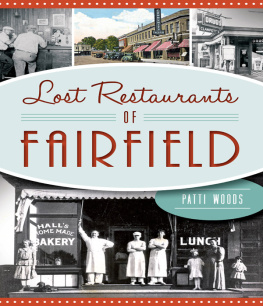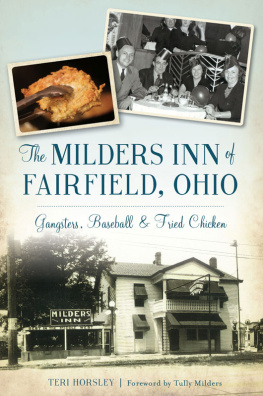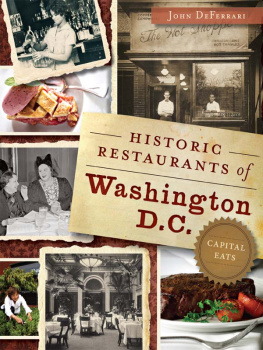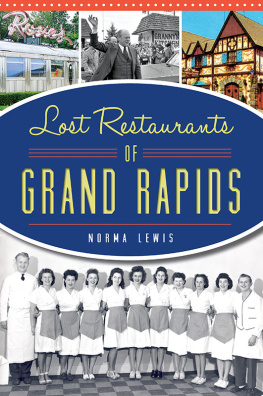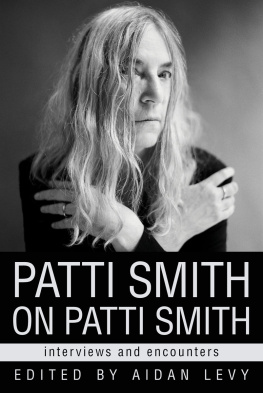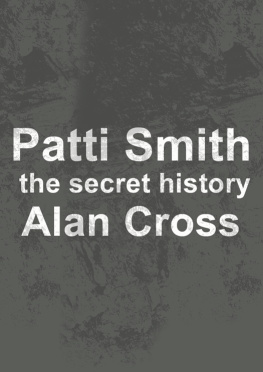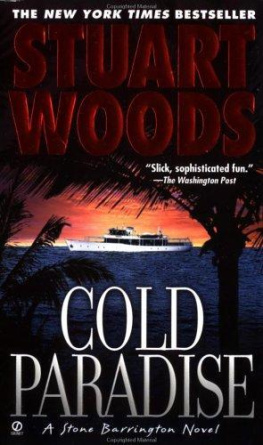

Published by The American Palate
A Division of The History Press
Charleston, SC
www.historypress.net
Copyright 2015 by Patti Woods
All rights reserved
First published 2015
e-book edition 2015
ISBN 978.1.62585.624.1
Library of Congress Control Number: 2015950740
print edition ISBN 978.1.46711.803.3
Notice: The information in this book is true and complete to the best of our knowledge. It is offered without guarantee on the part of the author or The History Press. The author and The History Press disclaim all liability in connection with the use of this book.
All rights reserved. No part of this book may be reproduced or transmitted in any form whatsoever without prior written permission from the publisher except in the case of brief quotations embodied in critical articles and reviews.
CONTENTS
ACKNOWLEDGEMENTS
When acquisitions editor Tabitha Dulla came to me with the idea for this book, I instantly fell in love with the project. It combined three of my passions: Fairfield, restaurants and history. Im grateful that she approached me and helped make the project a reality. Acquisitions editor Karmen Cook has been a wonderful support through this whole process. Thank you both for all your hard work.
I talked to countless people about their memories of Fairfields lost restaurants. They willingly offered their stories and photographs and shared joyful memories. To the family, friends and even complete strangers who offered the use of their photographs and ephemera, I thank you from the bottom of my heart.
This book wouldnt have been possible without social media. Two Facebook pages in particular were my go-to resources when I needed answers. Thank you to all the members of Life in Fairfield & Westport; your memories and stories helped immensely. Beth Bilyard, Whitney Mercurio and Ken Bullard, thank you for allowing me to constantly post on your page. And to the Fairdalers at You Grew Up in the Town of Fairfield, CT, pre-1990, your input was invaluable. Paul Brundage and Sandy Werthmann, I appreciate all your help.
To Elizabeth Rose and Ellen OMeara at the Fairfield Museum and History Center, your time and willingness to assist in this venture are so appreciated. Thank you Heather-Marie Montilla and all the folks at the Pequot Library who allowed access to the librarys resources.
It goes without saying that a project like this couldnt be accomplished without the support and encouragement from family and friends. Thank you to John Schwing, editor extraordinaire; I clung to your brilliant advice and reassurance during those dead-end days. Susan Siverson, I knew I could count on you for whatever I needed, whether it was a slice from Mikes or a daily text update. Thank you for always having my back. Thank you Heidi Gamma, your Sunday dinners filled my stomach and my soul; and Nick Gamma, your amazing photography and design skills never fail to impress me. Kara Canneythe Trumbull childrens librarian who brought me blueberry tea and shushed the noisy patronsyou rock. Amy Okrepkie, your flexibility and encouragement at my day job made the process so much easiernot to mention the best massages around. To all of the members of the Gaelic American Club who let me interrupt your dinner to talk restaurants, I raise my glass to you.
To my husband, Brian, and son, Henri, your patience and understanding during this time havent gone unnoticed. I couldnt ask for a better cheering section. You are my world.
Lastly, thank you to my parents. My mother, Joan Woods, unfailingly told everyone she met about this project and scouted out potential resourcesyou truly are the worlds best mom. My father, George Woods, passed away during the writing of this book. He shared with me the subtle joy that comes from a perfect turkey club and a glass of unsweetened iced tea. We always ordered the same thing at restaurants. I dedicate this book to him.
INTRODUCTION
To begin with, let me say: this is not a concise history of Fairfields gastronomic past. To attempt to cover each and every eatery that once operated in town would be a herculean task. If it could be accomplished, this book would then double as a door stop. There have just been too many food and drink establishments in the towns 375-year history to try to chronicle with any hope of 100 percent accuracy. Instead, this book contains the memories, stories and photos of a sampling of the towns most beloved restaurants. Some of the research came from old newspaper articles and saved bits of ephemera, but most of it came from oral historiesstories that have been passed down through the generations of people who owned, worked and patronized the towns businesses. Some of these lost restaurants are memorialized only in the old telephone directories, their tales having been forgotten over the years. Often, nothing exists but a simple text ad, like the one for Lollys from a 1939 directory that reads, Formerly the Red Barn Tavern, 43 Unquowa Road. SandwichesHot Meats. Rupperts Beer, Ballantines Ale. Newly Redecorated and Remodeled. Lolly Bogucki, Proprietor. One can only imagine Bogucki behind the bar wearing a white apron and serving up simple corned beef sandwiches with cold pints of ale.
Today, dining out is a regular occurrence for most families. But fifty years ago, the restaurant scene was different. When interviewing people for this book, I was told countless times, We didnt go out to dinner that often. Going out to a restaurant was a rare and special occasion. The importance of such opportunities was enough to create lasting memories of dressing up and being on ones best behavior, hands folded politely on the white tablecloth.
For more recent generations, though, dining out is a regular part of daily life. These stories consisted of weekly visits to the same restaurant, the same bar stool, the same table and the same waiter. For them, the memories of lost restaurants bring about a sort of nostalgia comparable to thinking of ones childhood home. These restaurants were places of familiarity, comfort and acceptance. In interviewing people for the chapter on bars, I was told on numerous occasions that certain bars were just like Cheersa place where everybody knew your name.
Part of the funand frustrationin researching this book was coming across restaurants Id never even heard of. The first time someone mentioned the Donald Duck, I thought they were kidding. The second time, my ears perked up. By the third mention, I was on the hunt. There were no articles or photos to be found anywhere, just vague recollections from people of an older generation. I finally uncovered an ad from an old directory that said, After the Minstrel, visit the Donald Duck Restaurant, 236 Kings Highway. Fine FoodsFinest LiquorsItalian SpaghettiMixed DrinksBeerWine. Open until 3 a.m. Its existence was confirmed.
Other times, there were restaurants that plenty of people had heard of or been to, but there was no documentation to be found. I desperately wanted to find an article, a menu, anything from the Thunderbird, the Rocket or the Roadside Inn, but I ended my searches empty-handed. One can only surmise that the historians of the past had no idea what a food-centric culture we would become. How could they ever have imagined that people would make a hobby out of reading cookbooks and actually watching people create meals on television? Surely they couldnt imagine a culture so fascinated by food that the term foodie would become part of the twentieth-first- century lexicon. So its only natural that they wouldnt have considered saving menus, placemats or recipes from local restaurants. Who would ever have an interest in such mundane things?
Next page
